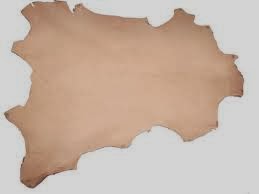OUGD504
DESIGN FOR PRINT
LEATHER RESEARCH
Vegetable tanning is an ancient and traditional craft process that tanneries have passed down over the years, using both ancient recipes and more recently state-of-the-art technology.
Vegetable tanning shows off leather in it's most natural state and you can really see the skill in the tanning process and also the finished product.
The transformation from raw hides into a material that will last a long time is a process that happens slowly in wooden drums or in tanning pits. Vegetable tanning is the most enviromentally friendly way to tan leather, there are no chemcals used respecting the environment due to the use of natural ingredients rather than chemicals. It is an astonishing process based on the use of natural tannins, using modern technologies and machinery but mainly it relies on the slow passage of time.
Among the various tanning methods, vegetable tanning is the most traditional and the most recognisable, it is the only form of tanning that is able to give leather unique characteristics, retaining the natural flaws and markings. It is also the most environmental-friendly. It is able to join comfort and look, fashion and tradition, uniqueness and versatility in the product.
Raw materials used for vegetable tanning are natural tannins, available in liquid or powder form, obtained from different part of plants including woods, barks, fruits, fruit pods and leaves. The most common tannins are obtained from Chestnut wood (Castanea sativa), Quebracho wood (Schinopsis lorentzii), Tara pods (Caesalpinia spinosa), Catechu (Acacia Catechu), Chinese gallnut (Rhustyphina semialata), Gambier (Uncaria gambir), Mimosa bark (Acacia meamsii), Oak wood (Quercus sp), Sumac (Rhustyphina coriaria), Turkish gallnut (Quercus infectoria) and Valonia Oak (Quercus macrolepis).
ADVANTAGES OF VEGETABLE TANNING
Vegetable tanning is environmentally friendly; meaning any leather products that have been vegetable tanned can be recycled.
Vegetable tanning is an age old tradition, so most tanneries have very skilled craftsmen producing and dyeing the leather.
Due to the natural tannins used, vegetable tanned products are unique and have their own life, they are not the same for their entire life, but they change, continuously, for the better developing a patina over time.
The colours that vegetable tanning produces are rich and warm tones that look completely natural.
Vegetable tanned leathers are more valuable and thus sold at a higher average price compared to chrome tanned leathers.
Vegetable tanning is environmentally friendly; meaning any leather products that have been vegetable tanned can be recycled.
Vegetable tanning is an age old tradition, so most tanneries have very skilled craftsmen producing and dyeing the leather.
Due to the natural tannins used, vegetable tanned products are unique and have their own life, they are not the same for their entire life, but they change, continuously, for the better developing a patina over time.
The colours that vegetable tanning produces are rich and warm tones that look completely natural.
Vegetable tanned leathers are more valuable and thus sold at a higher average price compared to chrome tanned leathers.
DISADVANTAGES OF VEGETABLE TANNING
The average process time of vegetable tanning is quite similar to chrome tanned leather but it can take up to 60 days to produce certain leathers.
Products that have been vegetable tanned are more expensive. They require much more skill to tan the hides, this means they are of better quality.
The colours you can produce from vegetable tanning are limited
Direct heat can cause vegetable tanned products to shrink or crack
The average process time of vegetable tanning is quite similar to chrome tanned leather but it can take up to 60 days to produce certain leathers.
Products that have been vegetable tanned are more expensive. They require much more skill to tan the hides, this means they are of better quality.
The colours you can produce from vegetable tanning are limited
Direct heat can cause vegetable tanned products to shrink or crack


















































